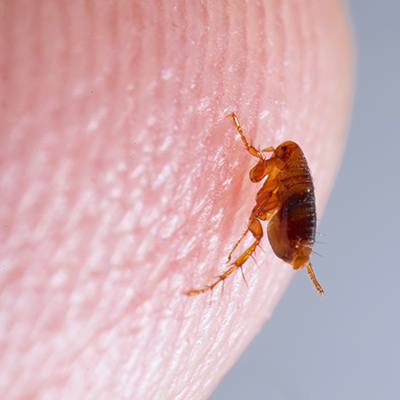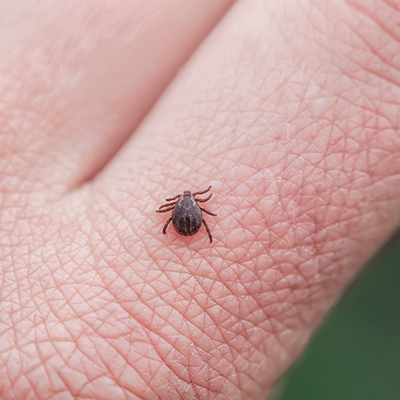While spring and summer are the most common seasons for diseases caused by ticks, Florida’s warm and humid climate is perfect for them to survive year-round. And while you may just be hanging around in your own backyard, your family could still be exposed to these harmful pests. Contrary to popular belief, fleas and ticks are not just found while walking, hiking, or camping. Because of this, it’s important to know how to identify fleas and ticks, the dangers they carry, and how to help prevent them from getting into your home. Read on for everything you need to know regarding fleas and ticks and the best ways to prevent them from ruining your summer.
What Do Fleas Look Like?
Fleas are reddish-brown and wingless, with narrow bodies no bigger than 1/6 of an inch long. Their tiny bodies are covered in hair to help them attach to their host and easily move about under a host’s fur. The most common fleas living in Florida are the cat flea, the dog flea, the human flea, and the sticktight flea.
Flea Behavior
Fleas prefer the blood of your pets rather than humans, so they are more likely to bite your animals. In nature, they are attracted to shady areas of your lawn or any other part of your yard where shade dwells. These include places like tall grass or beneath decks and porches. When your dog or cat frolics in the yard, the fleas can hitch a ride into your home. Fleas can live up to a year and produce millions of eggs. While fleas can bite humans, causing allergies, tapeworm, and murine typhus, they will typically choose your pet over you. They prefer to hide in fur.
What Do Ticks Look Like?
Ticks are a type of small arachnid. Here in Melbourne, Florida, we have several types of ticks, the deer tick, the American dog tick, the brown tick, and the lone star tick.
- Deer ticks, also known as black-legged ticks, are the primary carriers of Lyme disease. The deer tick is a hard-bodied black insect. After feeding, its abdomen turns a light-gray or blue color.
- The American dog tick, also known as the wood tick, is colorful.
- The brown dog tick or kennel tick is reddish-brown and is longer than the other ticks. It typically feeds mainly on dogs, as its name suggests.
- The lone star tick is named so for its white, star-shaped spot near the center of the adult female’s back.
Tick Behavior
Ticks live in moist, humid areas so Melbourne, Florida makes the prime environment. They can be found hiding out in wooded areas, under trees, inside of shrubs, and under decks and porches. If you live in the country, fleas and ticks love to hang out in the tall grass or overgrown areas where they wait for deer or other wildlife to pass by.
Why are Fleas and Ticks So Dangerous?
Fleas
Fleas like to irritate and harass our beloved pets, but they can also carry diseases that affect both your furry friends and us humans. Flea fecal matter and saliva can cause allergic reactions in both animals and humans. Fleas may carry tapeworms which can be ingested by cats, dogs, and even infants. Fleas can also carry Murine Typhus, a disease that fleas obtain by biting infected rats. They then carry this disease onto pets and/or humans that they bite. Symptoms include body aches, fever, and nausea.
Ticks
Ticks may carry Lyme Disease, which often has symptoms that mimic the flu, such as chills fever, joint pain, and fatigue. The bacteria that cause it can attack your major organs, including your heart, liver, and lungs. Most people also get a splotchy rash that starts on their ankles or wrists.
Less common than Lyme disease, Rocky Mountain Spotted Fever can cause fever, headaches, vomiting, stomach pain, red eyes, and sore muscles. Most people also get a splotchy rash that starts on their ankles or wrists, but if left untreated, RMSF can lead to a more serious illness.
Flea and Tick Prevention
There are always preventive actions you can take to help protect your family and pets. Keep your pets away from any shaded, tall grassy areas and keep your lawn as well-maintained as possible. This includes keeping your grass cut, your trees and bushes trimmed, and landscape beds cleaned. Be sure no branches are touching your house and clean up any falling debris as soon as it occurs, so these nasty critters can’t make it to their new home. Other ways to help prevent fleas and ticks include:
- Wear protective clothing. If you go hiking or need to do work in the backyard, wear long-sleeve shirts and long pants.
- When returning from the woods, or any highly shaded area, always inspect your clothing for any sign of fleas and ticks. Wear light-colored clothing so that they are easier to spot when you return.
- Use homemade tick sprays such as cedar oil and other essential oils.
- Groom your pet regularly.
- Use a flea and tick preventive for your pet. Most are sold at your local pet store or can be purchased through your veterinarian.
- Invest in professional flea and tick control.
Get Professional Flea and Tick Control From Flowers Turf and Pest Management
Don’t allow fleas and ticks to invade your lawn or home. Allow Flowers Turf and Pest Management to help. We can stop these parasites from wreaking havoc on your family and pets with our highly effective Flea and Tick Control. Allow us to send fleas and ticks packing and learn more now. Contact us via our online form, or give us a call at 321-254-1929.
Did you find the above article helpful? If so, feel free to share with family and friends. Then check out our other blog articles. Is there something else you would like to learn more about? Feel free to let us know. And don’t forget to follow us on Facebook.

